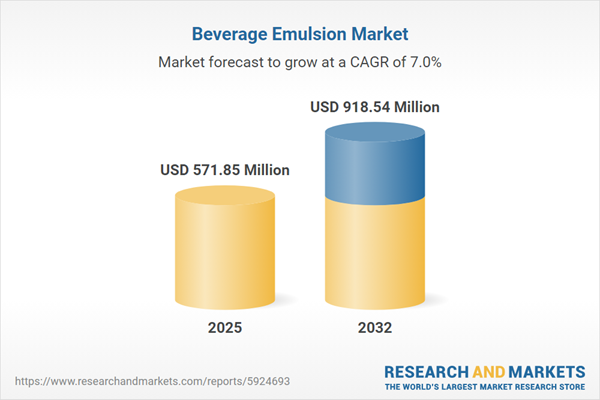Speak directly to the analyst to clarify any post sales queries you may have.
The beverage emulsion market is experiencing accelerated change as companies contend with evolving regulatory frameworks, shifting sustainability priorities, and disruptive technology trends. Senior decision-makers must employ strategies that synchronize with new consumer preferences and manage increasing supply chain intricacies to retain market relevance.
Beverage Emulsion Market Snapshot: Growth and Trends
The beverage emulsion market is projected to grow from USD 535.09 million in 2024 to USD 571.85 million by 2025, with further momentum expected to reach USD 918.54 million by 2032. This growth is being propelled by heightened demand for clean-label solutions and continuous process innovation. Leading industry participants are directing investments into ingredient optimization, supply chain resilience, and regulatory compliance. As organizations broaden their product offerings and reinforce sustainability and transparency, new opportunities are emerging for B2B companies to strengthen their market position and respond to increasingly sophisticated buyer requirements.
Scope & Segmentation of the Beverage Emulsion Market
- Applications: Beverage emulsions are utilized in alcoholic beverages, dairy-based drinks, fruit juices, soft drinks, functional beverages, as well as in personal care and pharmaceutical products. This broad application spectrum offers flexibility to meet compliance requirements in regulated sectors and facilitates the customizable integration of specialized ingredients.
- Emulsion Types: Oil-in-water and water-in-oil emulsions provide manufacturers with adaptable solutions that cater to unique texture and stability requirements for both beverage and non-beverage industries.
- Emulsifier Types: Predominant emulsifiers include lecithin, mono- and diglycerides, polysorbates, and sorbitan esters. The market’s transition toward plant-based and natural emulsifiers supports both sustainability objectives and evolving consumer demands for clean-label products.
- Product Forms: Beverage emulsions are available in both liquid and powder forms, optimizing production scalability and flexibility while supporting responsiveness to shifting manufacturing needs.
- Distribution Channels: Channels such as convenience stores, direct sales, specialty retail, online platforms, supermarkets, and hypermarkets ensure procurement flexibility for B2B customers seeking tailored and scalable purchasing strategies.
- End Users: Key segments include beverage producers, personal care manufacturers, and pharmaceutical companies, each benefitting from tailored solutions that meet industry-specific compliance and innovation needs.
- Regions: Growth is evident across North America, South America, Europe, the Middle East, Africa, and Asia-Pacific, driven by urbanization, evolving consumer habits, and regulatory developments. Regional expansion is fostering deeper market access and greater product localization.
- Companies Profiled: Major players such as Givaudan SA, International Flavors & Fragrances Inc., Symrise AG, Firmenich International SA, Kerry Group plc, Sensient Technologies Corporation, Döhler Group GmbH, Mane SA, Takasago International Corporation, and Robertet SA are emphasizing supply chain innovation and quality enhancement throughout production and distribution.
Beverage Emulsion Market: Key Takeaways
- Advanced processing, including high-pressure homogenization and microfluidization, is accelerating product development cycles and supporting consistent quality standards.
- Rising adoption of plant-based emulsifiers is promoting progress toward sustainability benchmarks and deepening supplier-buyer collaboration within the B2B segment.
- Enhanced compliance pressures are leading companies to optimize sourcing protocols and elevate accuracy across cross-regional operations, improving process reliability.
- Collaboration between ingredient suppliers, formulation experts, and manufacturers is expediting regulatory response and enabling more responsive, region-specific product offerings.
- Flexible distribution models and targeted regional strategies are proving essential for sustaining business operations and mitigating supply chain disruptions in volatile markets.
- Increased investment in functional, health-focused, and specialty beverage innovations is expanding the appeal of beverage emulsions in a market that values quality and differentiation.
Impact of 2025 U.S. Tariffs on Beverage Emulsion Supply Chains
The introduction of upcoming U.S. tariffs in 2025 on pivotal emulsifiers and related processing equipment is compelling B2B leaders to re-assess their supply chain frameworks. Action areas include reinforcing domestic sourcing capabilities, renegotiating supplier contracts, and upgrading logistics infrastructure. These strategies are intended to limit cost pressures and maintain reliable supply chains amid regulatory uncertainties.
Methodology & Data Sources
Findings are synthesized from in-depth executive interviews, regulatory authority insights, and technical expertise specific to the beverage emulsion sector. The analysis integrates comprehensive industry reviews, patent evaluations, and formal disclosures, providing a robust evidence base for business-critical decisions.
Why This Report Matters
- Enables senior executives to benchmark performance and adjust strategies in line with fast-changing sector trends.
- Supports management in optimizing procurement, enhancing risk mitigation, and navigating evolving regulatory expectations.
- Delivers practical, timely market segmentation and insight to steer innovation and anticipate shifts in regional demand.
Conclusion
Ongoing innovation, effective compliance management, and agile supply chain operations underpin successful long-term positioning in the beverage emulsion market. Companies focusing on these areas will be equipped to capitalize on emerging market opportunities.
Additional Product Information:
- Purchase of this report includes 1 year online access with quarterly updates.
- This report can be updated on request. Please contact our Customer Experience team using the Ask a Question widget on our website.
Table of Contents
3. Executive Summary
4. Market Overview
7. Cumulative Impact of Artificial Intelligence 2025
Companies Mentioned
The companies profiled in this Beverage Emulsion market report include:- Givaudan SA
- International Flavors & Fragrances Inc.
- Symrise AG
- Firmenich International SA
- Kerry Group plc
- Sensient Technologies Corporation
- Döhler Group GmbH
- Mane SA
- Takasago International Corporation
- Robertet SA
Table Information
| Report Attribute | Details |
|---|---|
| No. of Pages | 191 |
| Published | October 2025 |
| Forecast Period | 2025 - 2032 |
| Estimated Market Value ( USD | $ 571.85 Million |
| Forecasted Market Value ( USD | $ 918.54 Million |
| Compound Annual Growth Rate | 6.9% |
| Regions Covered | Global |
| No. of Companies Mentioned | 11 |









